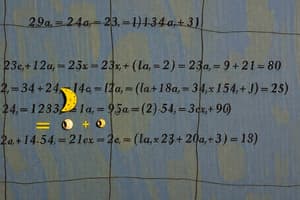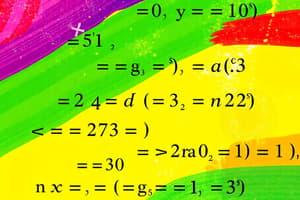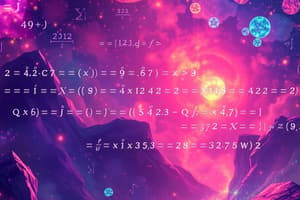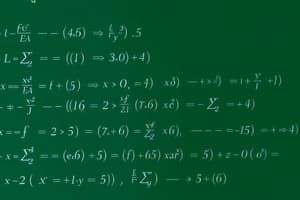Podcast
Questions and Answers
What is the primary purpose of using variables in algebra?
What is the primary purpose of using variables in algebra?
- To create expressions that remain static
- To simplify numerical computations
- To represent constant values in equations
- To represent unknown or changing values (correct)
Which of the following best describes an algebraic expression?
Which of the following best describes an algebraic expression?
- A combination of constants and variables without an equal sign (correct)
- A statement showing the relationship between two equations
- Only numerical calculations performed in isolation
- An equation with an equal sign
What is the correct application of the addition property of equality?
What is the correct application of the addition property of equality?
- If a = b, then a + c = b + c (correct)
- If a = b, then a + d = b - d
- If a + c = b, then a = b - c
- If a = b + c, then a - c = b
In the general form of a linear equation, what does 'A' represent?
In the general form of a linear equation, what does 'A' represent?
Which property of equality ensures that if a = b, then b = a?
Which property of equality ensures that if a = b, then b = a?
What distinguishes an equation from an expression in algebra?
What distinguishes an equation from an expression in algebra?
Which of the following is an example of a linear equation?
Which of the following is an example of a linear equation?
What is essential for solving an equation in algebra?
What is essential for solving an equation in algebra?
Flashcards
Algebra
Algebra
A branch of mathematics that uses symbols to represent and manipulate numbers and quantities.
Variable
Variable
A symbol, often a letter (like x, y, or z), that represents an unknown or changing value.
Constant
Constant
A specific numerical value that stays the same throughout a problem.
Algebraic Expression
Algebraic Expression
Signup and view all the flashcards
Equation
Equation
Signup and view all the flashcards
Solving an Equation
Solving an Equation
Signup and view all the flashcards
Linear Equation
Linear Equation
Signup and view all the flashcards
Property of Equality
Property of Equality
Signup and view all the flashcards
Study Notes
Fundamental Concepts
- Algebra is a branch of mathematics that uses symbols to represent numbers and quantities.
- It involves manipulating these symbols according to specific rules and properties to solve equations and inequalities and determine unknown values.
- Key components of algebra include variables, constants, expressions, equations, and inequalities.
Variables and Constants
- Variables are symbols, often letters (like x, y, or z), that represent unknown or changing values.
- Constants are specific numerical values that remain the same throughout a problem.
- Distinguishing between variables and constants is crucial to understanding algebraic expressions and manipulating them.
Expressions
- Algebraic expressions are combinations of variables, constants, and mathematical operations (addition, subtraction, multiplication, division, exponents).
- Examples of expressions include 2x + 5, 3y - 7 , or x² + 2x - 1.
- Expressions do not contain an equal sign, and are not seeking to equate any values.
- Evaluating an expression involves substituting specific values for the variables in the expression and calculating the result.
Equations
- Equations are statements that show the equality of two algebraic expressions.
- They contain an equal sign (=).
- Solving an equation involves finding the value(s) of the variable(s) that make the equation true.
- A key principle in solving equations is the preservation of equality—performing the same operation on both sides of the equation.
Properties of Equality
- Properties of equality govern how equations can be manipulated.
- These properties ensure that the solutions remain unchanged when certain operations are applied to both sides.
- Examples of important properties include:
- Addition property of equality: If a = b, then a + c = b + c.
- Subtraction property of equality: If a = b, then a - c = b - c.
- Multiplication property of equality: If a = b, then ac = bc.
- Division property of equality: If a = b, and c is not zero, then a/c = b/c.
- Reflexive property of equality: a = a.
- Symmetric property of equality: If a = b, then b = a.
- Transitive property of equality: If a = b and b = c, then a = c.
Solving Linear Equations
- Linear equations are equations where the highest power of the variable is 1.
- The general form of a linear equation is Ax + B = C, where A, B, and C are constants.
- Systems of linear equations involve finding the values for two or more variables that make multiple equations true at once.
- Common techniques for solving linear equations include combining like terms, using the distributive property, isolating the variable, and checking solutions.
Inequalities
- Inequalities represent relationships where one expression is greater than (>), less than (<), greater than or equal to (≥), or less than or equal to (≤) another.
- Solving inequalities follows similar steps to solving equations, but with one key difference: when multiplying or dividing both sides by a negative number, you must reverse the inequality sign.
Graphing Linear Equations
- Graphing linear equations visually represents the solutions of the equation on a coordinate plane.
- The graph of a linear equation is a straight line.
- The x- and y-intercepts represent where the line crosses the x- and y-axes, respectively. These points can be instrumental in plotting the line.
Applications of Algebra
- Algebra is used in numerous real-world applications, including:
- Solving problems involving geometry (such as finding areas, volumes and other measures of figures)
- Calculating simple and compound interest.
- Modeling scientific phenomena.
- Analyzing economic data.
- Understanding the relationships among different quantities.
Simplifying Mathematical Expressions
- Simplifying expressions involves rewriting them in a more compact or manageable form.
- Key to simplifying expressions correctly is knowing and applying the order of operations (PEMDAS, or, more commonly, BEDMAS). This includes knowing how various operations interact i.e. multiplication/division have a precedence relationship with addition/subtraction.
- Combining like terms and using the distributive property are crucial skills.
- Simplifying an expression requires adherence to mathematical properties and rules.
Studying That Suits You
Use AI to generate personalized quizzes and flashcards to suit your learning preferences.




